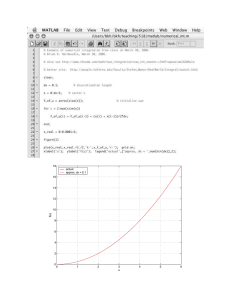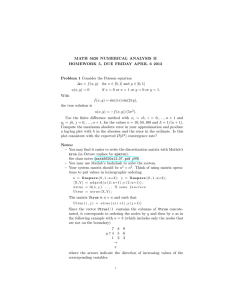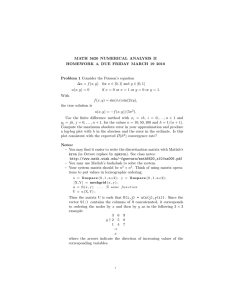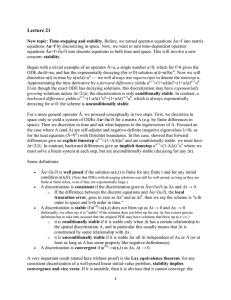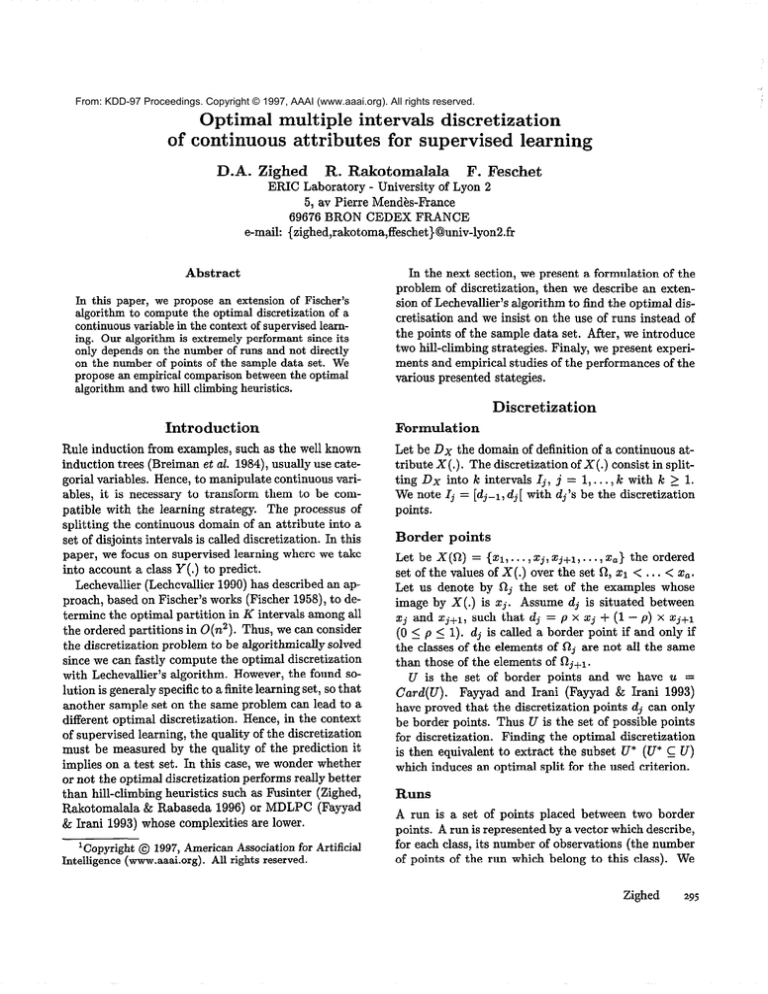
From: KDD-97 Proceedings. Copyright © 1997, AAAI (www.aaai.org). All rights reserved.
Optimal multiple intervals discret hat ion
of continuous attributes for supervised learning
D.A.
Zighed
R. Rakotomalala
F. Feschet
ERIC Laboratory - University of Lyon 2
5, av Pierre Mend&s-France
69676 BRON CEDEX FRANCE
e-mail: {zighed,rakotoma,ffeschet)@univ-lyon2.fr
Abstract
In this paper, we propose an extension of Fischer’s
algorithm to compute the optimal discretization of a
continuous variable in the context of supervised learning. Our algorithm is extremely performant since its
only depends on the number of runs and not directly
on the number of points of the sample data set. We
propose an empirical comparison between the optimal
algorithm and two hill climbing heuristics.
In the next section, we present a formulation of the
problem of discretization, then we describe an extension of Lechevallier’s algorithm to find the optimal discretisation and we insist on the use of runs instead of
the points of the sample data set. After, we introduce
two hill-climbing strategies. Finaly, we present experiments and empirical studies of the performances of the
various presented stategies.
Discretization
Introduction
Formulation
from examples, such as the well known
induction trees (Breiman et al. 1984)) usually use categorial variables. Hence, to manipulate continuous variables, it is necessary to transform them to be compatible with the learning strategy. The processus of
splitting the continuous domain of an attribute into a
set of disjoints intervals is called discretization. In this
paper, we focus on supervised learning where we take
into account a class Y(.) to predict.
Lechevallier (Lechevallier 1990) has described an approach, based on Fischer’s works (Fischer 1958), to determine the optimal partition in K intervals among all
the ordered partitions in O(n2). Thus, we can consider
the discretization problem to be algorithmically solved
since we can fastly compute the optimal discretization
with Lechevallier’s algorithm. However, the found so-
Rule induction
lution is generaly specific to a finite learning set, so that
another sample set on the same problem can lead to a
different optimal
discretization.
Hence, in the context
of supervised learning, the quality of the discretization
must be measured by the quality of the prediction it
implies on a test set. In this case, we wonder whether
or not the optimal discretization performs really better
than hill-climbing heuristics such as Fusinter (Zighed,
Rakotomalala & Rabaseda 1996) or MDLPC (Fayyad
& Irani 1993) whose complexities are lower.
‘Copyright @ 1997, American Association for Artificial
Intelligence (www.aaai.org).All rights reserved.
Let be Dx the domain of definition of a continuous attribute X( .). The discretization of X( .) consist in splitting DX into k intervals 1j, j = 1,. . . , k with k 2 1.
We note Ij = [dj-1, dj [ with dj’s be the discretization
points.
Border
points
Let be X(Q) = (21,. . . , xj, xj+l,. . . , za} the ordered
set of the values of X(.) over the set R, 21 < . . . < xn.
Let us denote by fij the set of the examples whose
image by X(.) is sj. Assume dj is situated between
xj and ~j+l, such that dj = p X ZT~+ (1 - p) X xj+l
(0 5 p 5 1). dj is called a border point if and only if
the classesof the elements of Rj are not all the same
than those of the elements of !2j+l.
U is the set of border points and we have u =
Card(U).
Fayyad and Irani (Fayyad & Irani 1993)
have proved that the discretization points dj can only
be border points. Thus U is the set of possible points
for discretization. Finding the optimal discretization
is then equivalent to extract the subset U* (U” C U)
which induces an optimal split for the used criterion.
Runs
A run is a set of points placed between two border
points. A run is representedby a vector which describe,
for each class, its number of observations (the number
of points of the run which belong to this class). We
Zighed
295
can then represent the sample set by an array T as the
IT-II---L--.
Iollowlllg:
It is clear that the number of runs is equal to the
number of border points plus one: T = u -t 1.
x
-v
x
R,
4
4
dl
000
d4 ds
0
X
-o--!z---e--s-a--)-
0
X
0
x
RX
R4
Rs
R,
works (Fischer 1958) for finding optimal discretization,
m.L,,.WU"bt:
xx
l
Optimal
discretization
Measuring
the quaiity of a partition
The problem consists in finding the split from which
we can predict the class Y(.) at best. Every subset
Ui C U of border points leads to a partition perfectly
described by an array Ti whose structure is similar to
T.
We necessarily have to compare partitions containing different numbers of intervals. The quality measure, we shall use, must take into account the increase in complexity induces by an excessive partitionning. There are several ways to introduce complexity bias to avoid excessive partitionning. We can
quote measures based on Minimum description length
principle (Fayyad & Irani 1993)) measures of the type
X2 (Tschuprow, Cramer), or measures using informational gain taking into account sample size (Zighed,
Rakotomaiaia & Rabaseda i996j. These measures can
possibly be guided by resubstitution error rate (Liu &
Setiono 1995).
From now on, we use Zighed’s measure denoted ‘p( .).
We have carried out several experiments which conclude that these different measures have the same be1.
c--f ..- A.----,
I- A.^ PIrl
^_^__
-1, &I., .-...__-." rr*
ndv1ouL‘.
wu1' g"al
IS b" 111111 iirlll"IIg
an UK aLla,ycl
1
if 5c-d
QI?iV if fnr
J -- ---
PVPrV
-‘---J
fyc
eiPmen.~s
T’i SlTIrl V:
-7 ----2
of X (0) which belong to the same interval 4, every
element situated between xi and zj belongs to the
same interval;
R7
Figure 1: The runs Ri and the border points dj for a
sample set composed of two classes “x” and “0”. The
sequencescan be homogeneous: (RI, R2, RG, R7) or not
(izs, &, iis j. in the first case, all points have the same
value for Y(.) and in the last case, all points have the
same value for X (.).
).
ordering elements property
: over the set
X(i-2) = {Xl)...) x,} a partition in k intervals is or&&
0
%
A(-21
15 "(7‘
This algorithm use two fundamental hypothesis
which are:
%
x
. . ..--l^-..r-.c"lup'eTuby
l
Additivity
of the quality measure: if a partition
***, 4) in k intervals is optimal, then
the partition (12, . . .. Ik) is an optimal partition in
k - 1 intervals of the set (IC;+~, ... . zcn).
(+%...,xi),
12,
The first property is not restrictive since X (0) C
lR the element are necessarily ordered. But, the second
property requires the additivity of the choozen measure. It has been proved by Lechevallier (Lechevallier
1990) for the measure based on a x2, and by Zighed &
al. (Zighed, Rakotomalala & Rabaseda 1996) for the
previous cp(.) measure.
An extension
of Fischer’s
algorithm
Fischer’s algorithm is a dynamic programming procedure. The main idea is to find some relations between
the optimal partition in k intervals of the inital data
set and the optimal partitions in k - 1 intervals of subsets of the data set. It uses the order to restrict the
number of possible partitions. The additivity of the
cp measure is then used to obtain a recurrent equation between optimal partitions. We present here an
extention of Fischer’s and Lechevallier’s algorithms by
considering the partitionning of a set of runs instead of
points. This is a consequenceof the work of (Fayyad
& Irani 1993) who have proved than a run can never
be split in an optimal discretization.
Let us consider a set of runs (Ri, 1 5 i 2 r). We
search an ordered partition which is optimal for the
‘p measure. We denote by Pi this partition with k
the number of intervals and 1 the first run taken into
account. We then have:
which one verifies: cp(T*) = mini[(p(Ti)].
An algorithm
for finding optimal
discretization
Finding optimal discretization in k classes with a set
of n points could be done by testing all the possible
partitions. In this case, the algorithm has a very high
mwnnlPvit,r
t,"rrr~L"nr"J
"fu,J+11
\' Y
R11t.
YY”,
T.prhmmllim
Y”v~~~...w&--“~
IT,nrhmmllier
\ ---**.,.
---I-
1990) has proposed’an algorithm based on Fischer’s
296
KDD-97
Since
cp
is
additive,
the
value
of
cp
partition
’
given
by
oc”g, Fr{ R,P_:FTY
, Rj< >> where r;c = 0 and
jh = r for the sake of simplicity. This additivity of cp
implies that
is an optimal partition in Ic - 1 intervals of the set
of runs {Ri, jl + 1 < i 5 T}. Hence, there are connections between the optimal partition in ir, intervals and
those in Ic - 1 intervals. The problem is then to find
the first cutting point jr. This point is one of the integers interval [l, r - k + 11. The optimal partition Pi
can then be obtained through a minimization process:
‘P(P,~)
= I<jl~~k+l{~(IR1,...,R31))
+P (?:I-:‘)}
- The previous relation introduce a relation of recurrence between Pi and ‘PC-‘. If we can compute the
jl” , then by using the minimizavarious partitions Pk-r
tion procedure we deduce Pk. To compute the partitions ‘$y,
it is possible to use again the relation of
recurrence.
We obtain the following algorithm:
Computing the partitions Pi for 1 5 2 < T
For all p, 2 5 p 5 k, compute the partitions Pz for
each Q of the interval [l, T - p + l]
l
l
l
Compute the summations v({R,, . . . ,R,}) +
p (Piml) for q 5 0 I T
cp(‘Pj) is the minimum value of the previous ones
At step Ic of this algorithm, the optimal partition
Pi is determined when q = 1.
The partition P* which is optimal among all the
previous optimal partition, is given by: cp(P*) =
minjr,r ‘p (Pj’)
Two
hill-climbing
heuristics
(TD)
Bottom-Up
(BU) and Top-Down
strategies
Beside Fischer’s strategy whose complexity is 0(r2), it
is possible to use less complexity [O(T)] methods but
which are not optimal. They are used in most of the
contextual discretization algorithms published in the
litterature. These methods are based upon two hillclimbing heuristics:
l
l
the first one, called “top-down”, uses the “divide and
conquer” principle. It recursively computes a binary
partitionning of each previously computed sets until
a stopping rule is verified (Catlett 1991). The set U*
is iteratively built by adding discretization points.
the second one, called “bottom-up” uses an opposite
principle. Its starts from an initial partition defined
by U, the set of border points. Then, it iteratively
tries to aggregate adjacents intervals until the partition optimizes the measure (Zighed, Rakotomalala
& Rabaseda 1996) or until no aggregation is reliable
(Kerber 1991). In the last case, the set U* is built
by deleting points of the partition.
Theses two strategies run very fast but they have the
disadvantage of being irrevocable. Each added point
in U* with the “top-down” strategy cannot be deleted;
each deleted point in U* cannot be reintroduced in the
last strategy.
A previous studies (Zighed, Rakotomalala &
Rabaseda 1996) have showed that MDLPC (Fayyad
& Irani 1993) and Fusinter are very close, so we only
use this last algorithm here.
Is an optimal discretization
algorithm
useful1 or useless ?
We are now confronted to a simple choice: on one side
we have a very fast algorithm, on the other side an
algorithm, with a higher cost, but which provides a
global optimization. Is it interesting to use one of these
instead of the other one ?
In the context of supervised learning, one of our
main goals is to build a model having the minimum
error rate in prediction, which could be estimated by
applying the model on a sample set not used for learning, called test set. It is generally supposed that a
model which optimizes a criterion having good properties, especially the resistance to overfitting on noisy
data, will perform better in prediction. Hence, the
problem of learning is often reduced to an optimization problem. In this paper, we verify this hypothesis
by confronting the hill-climbing heuristics with our improvement of Fischer’s algorithm.
Experiments
Comparison
method
We compare the Fusinter method with Fischer’s strategy using the Breiman’s waves dataset (Breiman et
aZ. 1984). To do so, we have generated 11 learning
samples of 300 points each and a test sample of 5000
points. For any w taken from the learning sample and
the test sample, we dispose of a 21 components vectors
noted (Xr (w), . . . , Xj(w), . . . ,X21(w)) and of a label
Y(w). For each attribute Xj, we determine the best
discretization obtained on the learning sample and we
consider it like a decision tree with one depth level.
Then, we measure the quality of the discretization on
the test sample by the accuracy rate.
The two methods (Fusinter, Fischer) are compared
using a t-test for dependent samples. Critical value of
the test is to.975 = 1.96 for a 5% significance level, and
we found t* = 1.735. So, we conclude that Fischer’s
strategy is not significantly better than Fusinter.
Zighed
297
Table 1: Comparison Fusinter vs Fischer
Results and discussion
Three main results draw our attention:
in our experiments, Fusinter almost always found the
right number of intervals;
but nearly never find the optimal partition (29 times
over 231 trials);
this disadvantage does not significantly modify its
performance towards those of Fischer’s strategy if
we consider the error rate in prediction. Indeed, over
the 231 files, Fusinter is better than Fischer 73 times
and has similar performances 47 times. Using the
test procedure described above, the difference is not
significant for a 5% risk (table 1).
The doubts of several authors (Breiman et al. 1984)
on the usefullness of optimization in induction process
are confirmed in this paper. Our goal is to obtain the
lowest error rate in prediction with the simplest model
following Occam’s razor principle. Then, it is probably
not very interesting to use complex learning strategies.
We can get better results (in our experiments, for a
10% risk, we can conclude to the superiority of Fischer’s strategy) but they are not significant. Hence,
the choice of a method is more dependent on the faculty of understanding the model, on its simplicity or
its running time.
Moreover, we wonder whether an optimization procedure, which only uses the contingency tables information, is reliable. In fact, in this case, we neglect the
distribution of the samples. Let us consider a sample
belonging to a class Yr which is surrounded by elements
of a class Ya, then we can suppose that this point has
the wrong label or that this point is aberrant. There
:n ..finn:l.1c._^ ----^-^
,..,I.,,,
dlx
several1 --l..L:--S”lUbl”llD .A^
b” Ll.2,
c111s
pJ’“u’~M. T4.
Lb 13
y”D”1u’cT+r\IJ”
mix supervised and unsupervised methods (Dougherty,
Kohavi & Sahmi 1995) by introducing, for instance, a
measure which takes into account the relative distribution of the intervals in lR, by using the inertia (de
Merckt 1993) or the variance (Lechevallier 1990).
Conclusion
In this paper, we have established that the use of optimal discretization using a partition quality measure
has no significant improvement on the error rate in
prediction beside a simple hill-climbing heuristic.
298
KDD-97
Nevertheless, we have to qualify this conclusion.
Some works have proved that the loose of informations
introduced by discretization can hide the relations between the variables (Celeux & Robert 1993). Thus,
it would interesting to complete this study by trying
t0 chacterize the problems and the data (distribution,
noise level...) for which it is necessary to use optimal
discretization. It would be also interesting to study
the behaviour of different induction processes in relation with the various discretization methods.
References
Breiman, L.; Friedman, J.; Olshen, R.; and Stone, C.
1984. Classification and Regression Trees. California:
Wadsworth International.
Catlett, J. 1991. On changing continuous attributes
into ordered discrete attributes. Artificial IntelZigence
Journal 164-178.
Celeux, G., and Robert, G. 1993. Une histoire de discretisation (avec commentaires). La Revue du Modulad (11):7-43.
de Merck& T. V. 1993. Decision trees in numerical
attributes spaces. In Proceedings of the 13th IJCAI.
Dougherty, J.; Kohavi, R.; and Sahmi, M. 1995. Supervised and unsupervised discretization of continuous features. In Preiditis, A., and Russel, S., eds.,
Proceedings of the I”zueith Internationai i?onference
in Machine Learning.
Fayyad, U., and Irani, K. 1993. Multi-interval discretization of continuous-valued attributes for classification learning. In Proceedings of the 13th IJCAI,
1022-1027.
Fischer, W. 1958. On grouping for maximum homogeneity. Journal of American Statistical Association
(53):789-798.
Kerber, R. 1991. Chimerge discretization of numeric
attributes. In Proceedings of the 10th International
Conference on Artificial Intelligence, 123-128.
Lechevallier, Y. 1990. Recherche d’une partition opti.-lw. +,A‘.1
male so-uscontrainte d’orurr;
Ir”lal. 9-h,l.n:nn1
ICbIIIIILLu ..A..,..&
rr;yvr b)
INRIA.
Liu, H., and Setiono, R. 1995. Discretization of ordinal attributes and feature selection. Technical Report TRB4/95, Department of Sys. and Comp. Sci,
National University of Singapore.
Zighed, D.; Rakotomalala, R.; and Rabaseda, S. 1996.
A discretization method of continuous attributes in
induction graphs. In Proceedings of the 30th European
Meetings on Cybernetic
1002.
and Systems Research, 997-

